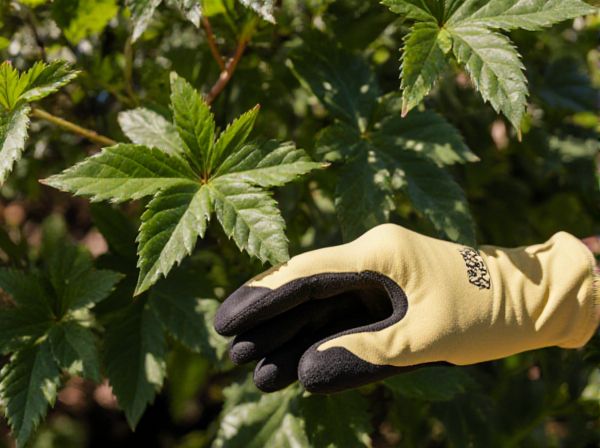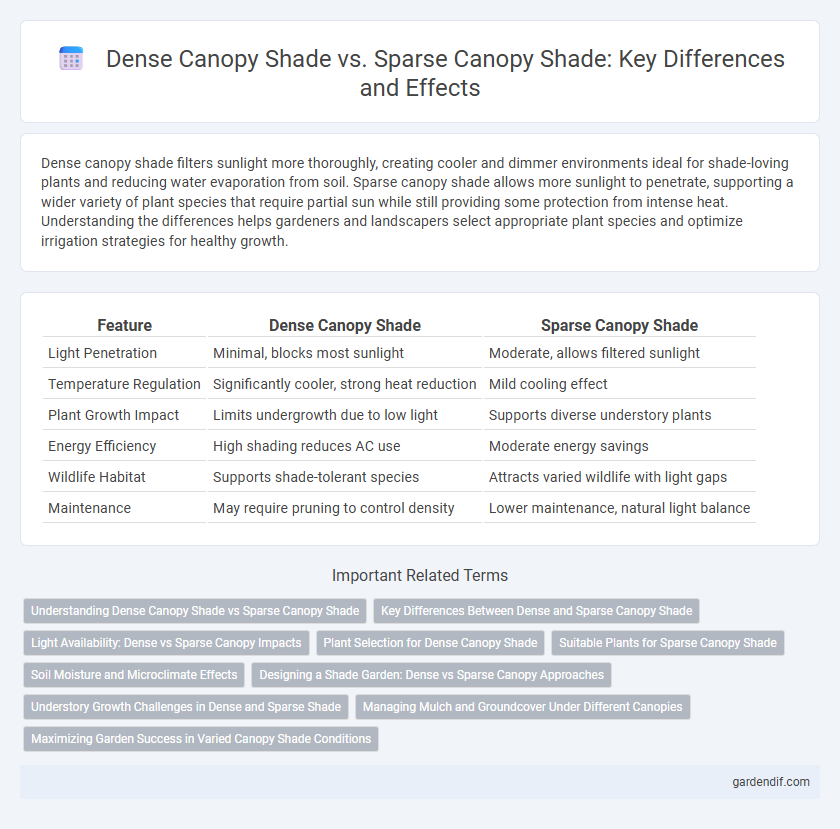
Dense Canopy Shade vs Sparse Canopy Shade Illustration
Dense canopy shade filters sunlight more thoroughly, creating cooler and dimmer environments ideal for shade-loving plants and reducing water evaporation from soil. Sparse canopy shade allows more sunlight to penetrate, supporting a wider variety of plant species that require partial sun while still providing some protection from intense heat. Understanding the differences helps gardeners and landscapers select appropriate plant species and optimize irrigation strategies for healthy growth.
Table of Comparison
| Feature | Dense Canopy Shade | Sparse Canopy Shade |
|---|---|---|
| Light Penetration | Minimal, blocks most sunlight | Moderate, allows filtered sunlight |
| Temperature Regulation | Significantly cooler, strong heat reduction | Mild cooling effect |
| Plant Growth Impact | Limits undergrowth due to low light | Supports diverse understory plants |
| Energy Efficiency | High shading reduces AC use | Moderate energy savings |
| Wildlife Habitat | Supports shade-tolerant species | Attracts varied wildlife with light gaps |
| Maintenance | May require pruning to control density | Lower maintenance, natural light balance |
Understanding Dense Canopy Shade vs Sparse Canopy Shade
Dense canopy shade occurs when tree leaves and branches form a thick overhead cover that significantly reduces sunlight penetration, creating cooler and darker ground conditions. Sparse canopy shade allows more sunlight to filter through gaps in the foliage, resulting in lighter shade and warmer temperatures beneath the trees. Understanding the degree of canopy density is crucial for gardeners and landscapers to select appropriate plants and manage growth conditions effectively.
Key Differences Between Dense and Sparse Canopy Shade
Dense canopy shade significantly reduces light penetration, creating cooler and more humid microclimates ideal for shade-tolerant plants, while sparse canopy shade allows more sunlight to filter through, supporting a wider variety of flora. Dense canopies often result in higher moisture retention and lower soil evaporation rates compared to sparse canopies, which experience increased light intensity and temperature fluctuations. The structural differences between dense and sparse canopies directly impact biodiversity, plant growth patterns, and understorey ecosystem dynamics.
Light Availability: Dense vs Sparse Canopy Impacts
Dense canopy shade significantly reduces light availability by blocking a large portion of sunlight, creating cooler, dimmer conditions beneath the foliage. Sparse canopy shade allows more filtered light to penetrate, supporting greater photosynthesis and understory growth due to increased light availability. The variation in light intensity influences plant species diversity, growth rates, and microclimate conditions in shaded environments.
Plant Selection for Dense Canopy Shade
Dense canopy shade creates low-light conditions that challenge photosynthesis, making it crucial to select shade-tolerant plants such as ferns, hostas, and astilbes. These species thrive under thick tree coverage by adapting to limited sunlight and often require moist, well-drained soil to maintain optimal growth. Incorporating understory shrubs like hydrangeas and dogwoods enhances diversity while ensuring survival beneath dense canopy shade.
Suitable Plants for Sparse Canopy Shade
Sparse canopy shade provides intermittent sunlight, making it ideal for plants that require partial light exposure. Suitable plants for sparse canopy shade include ferns, hostas, and astilbes, which thrive with filtered sunlight and moderate moisture. These plants benefit from the dappled light and reduced competition for nutrients typical of sparse canopy environments.
Soil Moisture and Microclimate Effects
Dense canopy shade significantly reduces soil moisture evaporation by limiting sunlight penetration, creating a cooler and more humid microclimate beneath the canopy. Sparse canopy shade allows greater sunlight exposure, resulting in higher soil moisture evaporation rates and warmer soil temperatures. These microclimatic differences influence plant water availability, soil microbial activity, and overall ecosystem health.
Designing a Shade Garden: Dense vs Sparse Canopy Approaches
Dense canopy shade creates a deeply shaded environment with limited sunlight, favoring shade-tolerant plants like ferns, hostas, and woodland wildflowers that thrive in moist, cool conditions. Sparse canopy shade allows dappled sunlight through, supporting a wider variety of plants such as astilbes, hellebores, and bleeding hearts that require partial sun to partial shade. Selecting between dense and sparse canopy approaches depends on desired plant diversity, microclimate conditions, and maintenance goals for the shade garden design.
Understory Growth Challenges in Dense and Sparse Shade
Dense canopy shade severely limits sunlight penetration, resulting in reduced photosynthesis and stunted understory growth, while sparse canopy shade allows more light, promoting better understory development but may increase competition for nutrients and water. Understory plants in dense shade often adapt with larger, thinner leaves to capture minimal light, whereas those in sparse shade typically exhibit more balanced growth patterns. Managing these growth challenges involves selecting shade-tolerant species and optimizing soil conditions to support healthy understory vegetation.
Managing Mulch and Groundcover Under Different Canopies
Dense canopy shade creates low light conditions that require moisture-retentive mulch materials such as bark or leaf mulch to prevent soil drying. Sparse canopy shade allows more sunlight, promoting faster mulch decomposition and necessitating more frequent mulch replenishment to maintain ground cover effectiveness. Selecting shade-tolerant groundcovers like pachysandra or ajuga adapts well to varying light levels under both dense and sparse canopies.
Maximizing Garden Success in Varied Canopy Shade Conditions
Dense canopy shade creates low-light conditions that challenge plant growth by reducing photosynthesis, requiring selection of shade-tolerant species like ferns and hostas to maximize garden success. Sparse canopy shade offers filtered light, supporting a wider variety of plants, including partial shade perennials and some vegetables, optimizing growth while protecting from direct sun. Understanding the varying light intensity and duration under dense and sparse canopies is essential for tailoring irrigation, soil enrichment, and plant placement, thereby enhancing garden productivity in different shade environments.
Dense Canopy Shade vs Sparse Canopy Shade Infographic

 gardendif.com
gardendif.com